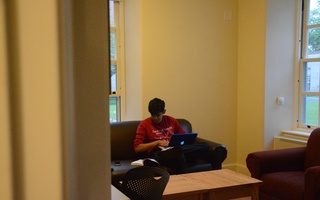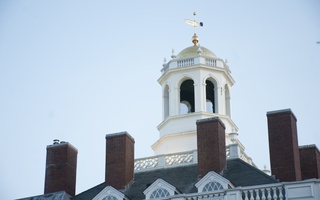UPDATED: April 24, 2018, at 11:51 a.m.
In Adams House’s renovation, history, modernity, and accessibility are set to become one.
Starting in the spring of 2019, Adams House is slated to undergo renovation. This comes in the context of the University’s push for housing renewal, with renovations already having taken place in all of Dunster and Winthrop Houses, and some of Quincy and Leverett Houses.
Unlike what is occurring in the ongoing Lowell House renovations, not all Adams residents will be required to live in swing housing at any given time. Since Adams consists of three separate buildings, as some undergo renovation, students who live in the other buildings can continue to do so.
From the Gold Room to Westmorly Court, Adams is filled with history—a history that should be preserved to the greatest extent possible. Thus, it is welcome news that the Cambridge Historical Commission will not allow the exterior of Adams to be changed. Furthermore, we are excited to hear that plans for Adams are seeking to preserve its more unique and nuanced historical features, including the Coolidge Room, the elliptical stairs in Randolph Hall, the lobby of Claverly Hall, the pool theater, and the suite of former President Franklin D. Roosevelt, Class of 1904.
This is in line with the desires of Adams students, who made their views known during a town hall. It’s a welcome sign that the architects have solicited student input during the beginning stages of the renovation process, and should to do so to an even greater extent as they continue their work.
In this vein and in line with the requests of Adams residents, the architects should continue to keep as much of the quirky, historical features of the House as possible—it is these facets that make Adams House unique. Indeed, other historic parts of Adams House are just as worthy of preservation, including the underground tunnels decorated by Adamsians past, the ornately designed Gold Room, the stunning House library, and much more.
However, at the moment, the only elevator in Adams is in Claverly Hall, and by the end of renovations, architects plan for there to be eight all around the House, and for all entryways to be accessible. This prioritization of accessibility is commendable, in that it works to make the House safe and inclusive. A continued emphasis on this aspect of renovation should be a key aim of the architects.
The renovation also allows for increased social space within the House, as students have requested. Students in other renovated Houses have explained that the loss of their own common rooms in suites to larger, public common rooms or off-corridor doubles constitutes a large loss to their ability to be social with other students. Those who have influence in the renovation should therefore listen to feedback from students from recently-renovated houses—particularly Dunster, Quincy, and Winthrop Houses—and emphasize the design of many suites with private common rooms. Not only would this demonstrate that those in charge of the renewal of Adams House have listened to the voices of students unhappy with this specific aspect of the renovations in other Houses, it will also facilitate a sense of community in Adams House and set an admirable precedent for future renovations.
In that vein, as each House is renewed, administrators and architects alike should be learning more about how to best renovate for undergraduate residential life at Harvard, and we hope they apply the lessons they should have learned to the particular case of Adams House correctly and with due diligence.
This staff editorial solely represents the majority view of The Crimson Editorial Board. It is the product of discussions at regular Editorial Board meetings. In order to ensure the impartiality of our journalism, Crimson editors who choose to opine and vote at these meetings are not involved in the reporting of articles on similar topics.
CORRECTION: April 24, 2018
A previous version of this editorial incorrectly stated the organization that is not allowing Adams House's exterior to be changed. It is the Cambridge Historical Commission, not the Cambridge Historical Society.
Read more in Opinion
Where Do We Go From Here?Recommended Articles
-
 After Critique, College Reevaluates Hall Common Rooms
After Critique, College Reevaluates Hall Common Rooms -
 Lowell’s Size Will Complicate Renovations
Lowell’s Size Will Complicate Renovations -
 Adams Students Ask Architects to Keep House Quirks in Renovation
Adams Students Ask Architects to Keep House Quirks in Renovation -
 New Adams Will Preserve Historic Decor, Improve Accessibility
New Adams Will Preserve Historic Decor, Improve Accessibility -
 Adams Bathroom Vandalism Prompts Allegations of Transphobia, Administrative Response
Adams Bathroom Vandalism Prompts Allegations of Transphobia, Administrative Response













